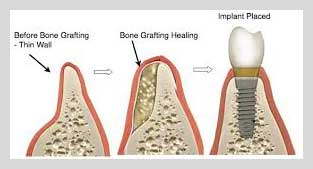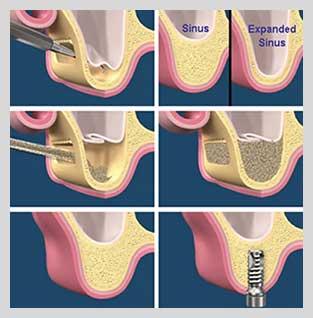Table of contents
Socket Preservation, Ridge Augmentation, Sinus Lift/Augmentation
A dental implant bone graft is a surgical procedure that replaces missing bone. The procedure is highly complicated and poses a severe health risk to the patient if not performed correctly. Dr. Rahmani is well-versed in all advanced bone grafting techniques to prepare the jawbone for dental implants.
Autogenous bone graft is the preferred technique in our center as there is less risk of graft rejection because the graft originated from the patient’s own body. All bone graft procedures are performed in our NYC Dental Implants Center in Midtown Manhattan.
Depending on the site of the bone loss and your individual needs, Dr. Rahmani, a top implant dentist in New York, will use one of several different techniques to help replace the missing bone.
Socket Preservation
When it is necessary to remove a tooth, the socket used to hold the tooth may have become damaged by disease or infection. Additionally, tooth removal can result in changes to the surrounding bone and gums.
Bone loss and gum recession can occur very soon after the tooth extraction, creating substantial problems for subsequent restorative dental implant procedures.
Socket preservation technique that can help enhance your new dental implant’s appearance and improve your chances of enjoying successful dental implant treatment for many years to come.

One popular socket preservation technique is to fill the empty socket with bone grafting material or artificial bone grafting material. Afterward, the bone grafting material may be covered up with a synthetic membrane containing special proteins to help stimulate your body to repair the empty socket and prevent the gum tissue from growing into the bone. The artificial membrane is then covered up with gum to protect it.
Strong and Stable Foundation for a Dental Implant
This method can be enormously successful, helping to eliminate the shrinkage and collapse of bone and gum tissue. The newly formed bone in the empty socket provides a strong and stable foundation for a dental implant.
Socket preservation can be particularly useful when replacing front teeth with either dental implants or mini dental implants (small diameter implants).
Furthermore, when tooth removal is necessary, Dr. Rahmani uses an advanced technique called atraumatic extraction. Not every dentist is trained and experienced in using it. Typically, tooth extraction is performed by moving the tooth from side to side until it is loose enough to be extracted. A special tool allows a corkscrew action to be used during an atraumatic extraction. This is far kinder to the surrounding tissue and bone, helping preserve it. Consequently, when socket preservation is needed, less bone grafting material is required.
Ridge Augmentation
 A ridge augmentation is another standard procedure carried out following tooth extraction. It helps to recreate the natural contour of the jaw and the gums that may have been lost due to bone resorption.
A ridge augmentation is another standard procedure carried out following tooth extraction. It helps to recreate the natural contour of the jaw and the gums that may have been lost due to bone resorption.
When a tooth root is removed it leaves an empty socket in the alveolar ridge, which is the raised ridge of bone that supports your teeth. Alveolar bone is a thickened ridge of bone that helps to protect the tooth sockets.
After tooth removal, the empty socket usually heals well on its own, gradually filling up with bone and gum tissue. Sometimes, when a tooth is removed, the alveolar bone surrounding the empty socket will begin to break down, causing the alveolar ridge loss of height and width.
Purpose of a Ridge Augmentation
The purpose of ridge augmentation is to rebuild the ridge to its original height and width.
The ridge augmentation procedure ensures that dental implants have plenty of bone to support them. It also helps to ensure pleasing aesthetics once the implants are restored with replacement teeth.
It is possible to carry out a ridge augmentation while natural teeth are removed by placing bone grafting material into the empty socket. Another option is to have the ridge augmentation carried out at a later date.
Time to Heal
Generally, ridge augmentation bone grafts need to heal for four to 6 months before dental implant placement. However, occasionally, it might be possible to place the implant simultaneously as the ridge augmentation. Sometimes Dr. Rahmani also suggests a soft tissue ridge augmentation. We can ensure that the alveolar ridge has the correct contours by replacing any lost gum tissue so the final implant restoration will look aesthetically pleasing.
Patient
Testimonials
My experience with Dr. Rahmani has been absolutely fantastic! He is extremely well-versed, knowledgable and able to communicate clearly which made me feel welcomed and in good hands. I felt he gave not only the proper attention and care to my case but went above and beyond to ensure minimal impact on my daily life while ensuring the best recovery and end-results. He was able to perform magic and maintain my original front tooth as a temporary implant prior to permanent replacement!!! He made an extremely stressful, difficult situation feel easy, simple and aesthetically beautiful! He is amazing and I am so grateful that I found him. I highly recommend entrusting him! His staff is wonderful and caring as well! It was extremely easy to keep in contact with them whenever I felt I needed to. All around extremely, extremely outstanding experience. The office is conveniently located, clean, professional and overall pleasant to visit!
Rosanna De LUCA
Dr. Rahmani and his staff are amazing! I had a problem with my existing implant and they were able to remove it and replace it which was extremely complicated. They were there every step of the way and always friendly, available and ready to help. I don’t think any other Dr. could have done this work. I highly recommend him and his entire team!!
Karen Gardner
Sinus Lift/Augmentation
 Sinus lift procedure is very common when using dental implants to replace upper back teeth.
Sinus lift procedure is very common when using dental implants to replace upper back teeth.
The maxillary sinuses are located just above your upper jaw, either side of your nose and are empty, air-filled spaces.
Natural tooth roots can extend up into these maxillary sinuses, and often after they are removed, there will only be a thin wall of bone remaining in between the sinuses and the mouth. This tissue is not sufficient to support dental implants, which is why you may need a sinus lift or graft.
Sinus lift augmentation procedure helps strengthen and build up the bone in the area around your sinuses, ensuring dental implant treatment will be a success.
Sinus Lift Procedure
To do this procedure, Dr. Rahmani makes an incision in your gums to expose the jawbone directly underneath your sinuses. A small opening is then cut into the bone, exposing the membrane between your sinuses and jawbone.
The membrane is gently lifted or pushed upwards, creating a space between the membrane and your jawbone, which can then be filled with bone grafting material. Once the bone graft is in position, the incision in your gums are stitched up, and the healing process begins.
Sometimes it is possible to carry out a sinus augmentation while placing your dental implant. Still, if a substantial amount of bone is needed, it may be better carried out as a separate procedure, and the bone graft will need to heal for several months before your implant can be inserted.
If you have any questions about Bone Graft Techniques in NYC or to make an appointment with best-rated implant dentist Dr. Rahmani, please call the NYC dental implants center:
NYC Dental Implants Center
121 East 60th St Ste 6C2
New York, New York 10065
(60th St. btw Park Ave / Lex Ave)
212-256-0000
Consultation
